Culture & Tourism
Culture to Pride, Progress in Every Step
Posted On: 02 JUN 2025 7:13PM
“We must keep our culture, civilization and values alive, preserve and enhance our spirituality and diversity, while continuously modernizing technology, infrastructure, education and health systems.”
~Prime Minister Shri Narendra Modi
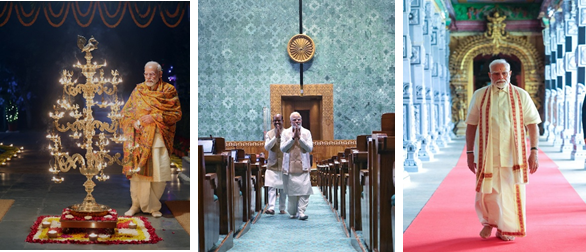
Introduction
Over the past 11 years, under the leadership of Prime Minister Narendra Modi, India’s cultural journey has flourished like a rangoli: colorful, rooted in tradition and open to the world. From the timeless temples of Hampi to the living traditions of classical music and dance, the government has given new energy to both tangible and intangible heritage. Forgotten heroes have been remembered and ancient knowledge has been preserved through modern tools. Together, these efforts proudly carry the spirit of Bharat to the world.
India's Cultural Rebirth
From the grand Kashi Vishwanath Corridor to the divine presence of Ram Lalla in Ayodhya, the government is preserving heritage and deepening cultural roots. Through spiritual circuits and modern pilgrim amenities, India’s civilizational pride is being seamlessly revived.

1. Redevelopment of Temple Corridors and Pilgrimage Sites
|
Project/Site
|
Initiative Taken
|
|
Kashi Vishwanath Corridor, Uttar Pradesh
|
The Kashi Vishwanath Corridor project has revitalized Varanasi by transforming its ancient ghats, narrow lanes and temple access.
|
|
Mahakaal Lok Project Ujjain, Madhya Pradesh
|
The Mahakaal Lok Project was launched to provide world-class amenities and spiritual ambience, enriching the pilgrim experience at the revered Mahakaleshwar temple.
|
|
Ma Kamakhya Temple, Assam
|
The development of the Ma Kamakhya Temple focused on enhancing infrastructure and pilgrim facilities, ensuring a more comfortable and accessible spiritual experience.
|
|
Ram Mandir, Ayodhya
|
Bhoomipujan for Ram Mandir was held in August 2020; the grand temple was inaugurated on January 22, 2024.
|
|
Kedarnath Temple, Uttarakhand
|
The integrated development of Kedarnath includes the installation of the Adi Shankaracharya statue, symbolizing civilizational unity and enhancing the spiritual significance of the pilgrimage site.
|
|
Reconstruction of Juna Somnath Temple, Development of Promenade and Parvati Mandir, Gujarat
|
PM Modi continues the legacy of Ahilyabai Holkar by rejuvenating key pilgrimage sites, including development around Somnath temple and the construction of Parvati Mandir. Also, developed promenade offering pilgrims a majestic view of the Somnath Temple against the Arabian Sea.
|
2. Enhancing Pilgrimage Connectivity
|
Project
|
Work Done
|
|
Char Dham Highway Project
|
Chardham project comprises improvement of 5 existing National Highways (NHs) connecting Chardham viz. Yamunotri, Gangotri, Kedarnath and Badrinath including Tanakpur to Pithoragarh section of Kailas-Mansarovar yatra, aggregating a length of about 825 km. As of July 2024, 616 km out of the total 825 km length has been completed.
|
|
Hemkund Sahib Ropeway
|
The Cabinet Committee on Economic Affairs (CCEA) has approved a 12.4 km ropeway project from Govindghat to Hemkund Sahib Ji in Uttarakhand. The total cost of the project is ₹2,730.13 crore.
|
|
Buddhist Circuit
|
- Uttar Pradesh (2016–17): ₹87.89 crore allocated for the development of key Buddhist sites in Sravasti, Kushinagar, and Kapilvastu.
- Andhra Pradesh (2017–18): ₹35.24 crore invested in enhancing connectivity and amenities across Shalihundam, Bavikonda, Bojjanakonda, Amravati and Anupu.
- Bihar (2016–17): ₹95.18 crore sanctioned for developing the Buddhist Circuit, including a Convention Centre at Bodh Gaya.
- Gujarat (2017–18): ₹26.68 crore allocated to develop Buddhist heritage sites in Junagadh, Gir Somnath, Bharuch, Kutch, Bhavnagar, Rajkot, and Mehsana.
- Madhya Pradesh (2016–17): ₹74.02 crore for the integrated development of the Buddhist Circuit covering Sanchi, Satna, Rewa, Mandsaur and Dhar.
|
|
Kartarpur Sahib Corridor
|
On November 9, 2019, the Kartarpur Corridor was inaugurated enabling Indian Sikh pilgrims to access Gurdwara Darbar Sahib in Kartarpur.
|
3. Inclusive Heritage Development
Besides developing major heritage corridors and iconic sites, the government is taking a holistic approach to preserving and promoting religious diversity. Through schemes like PRASHAD (Pilgrimage Rejuvenation and Spiritual, Heritage Augmentation Drive), efforts have been made to rejuvenate key places of worship across different faiths; including mosques, churches and shrines, ensuring that India’s rich spiritual mosaic is respected and celebrated. This inclusive development strengthens communal harmony while preserving cultural heritage.
These initiatives go beyond restoring monuments, they are helping rebuild communities and revive local economies. Under the PRASHAD (Pilgrimage Rejuvenation and Spiritual, Heritage Augmentation Drive) scheme, nearly ₹1,900 crore has been invested in the development of cultural and spiritual sites across the country.
The Swadesh Darshan scheme has further boosted travel infrastructure, with ₹5,292.91 crore sanctioned for 76 projects across identified thematic circuits. Building on this momentum, Swadesh Darshan 2.0 has approved 34 more projects for the period 2023–25.
Complementing these efforts, the HRIDAY (Heritage City Development and Augmentation Yojana) scheme has focused on developing 12 heritage cities. Together, these initiatives are preserving India’s spiritual and cultural heritage while driving a surge in tourism across the country.
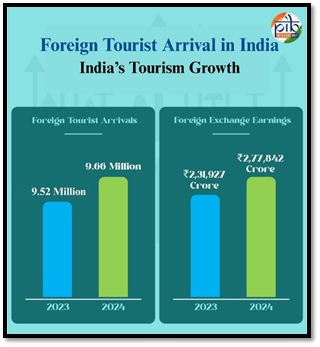
The economic impact of these efforts is tangible. In 2024, India recorded 9.66 million foreign tourist arrivals, generating ₹2,77,842 crore in foreign exchange earnings. These numbers reflect not just rising travel interest but the growing confidence in India’s upgraded infrastructure and its renewed cultural appeal.
Bringing Back the Lost Heritage
Bringing back the nation’s lost heritage has been a priority for the government. Before 2013, only 13 stolen antiquities had been returned to India from abroad. However, since 2014, 642 stolen antiquities have been traced and are at various stages of being brought back to the country.
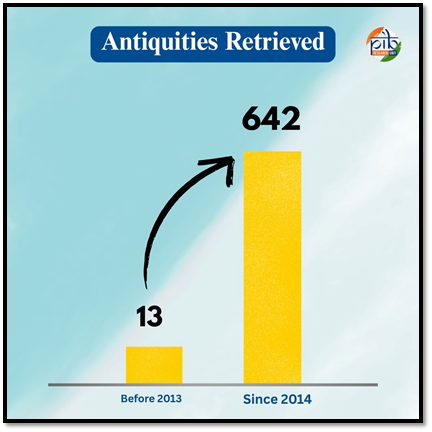
Since 2016, the US Government has facilitated the return of many trafficked or stolen antiquities. 10 antiquities were returned during PM’s visit to USA in June 2016; 157 antiquities during his visit in September 2021 and a further 105 antiquities during his visit in June 2023. The total number of cultural artefacts returned from US to India since 2016 stands at 578. This is the maximum number of cultural artefacts returned by any country to India.
Recognition to Wide Range of Nation Builders
The government has taken significant steps to honour India’s true nation-builders, ensuring their legacies are preserved and celebrated beyond political lines. A key initiative in this direction was Azadi Ka Amrit Mahotsav, launched on 12 March 202 and concluded on 15 August 2022, commemorating 75 years of India's freedom. The campaign honored the sacrifices and achievements that shaped the nation through cultural and patriotic events held nationwide. Complementing these efforts are iconic statues, immersive museums and memorials that rekindle public memory and inspire future generations to carry forward the spirit of nation-building.
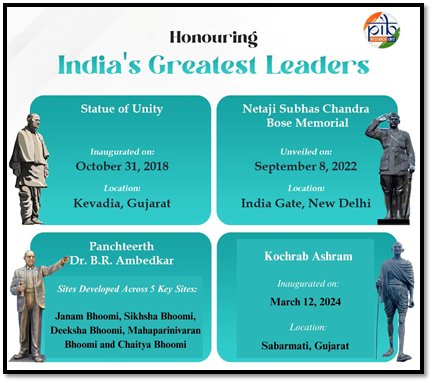
The central government has recognized numerous nation-builders, honoring their contributions impartially and beyond political biases.
Honouring Legacy, Showcasing Nation
To honour the legacy of India’s heroes the Modi government has transformed long-pending memorials into powerful symbols of national pride. From soldiers to statesmen, every effort reflects a deep commitment to remembering those who shaped the nation’s journey.
Key Highlights:
- Pradhan Mantri Sangrahalaya: The Pradhan Mantri Sangrahalaya was inaugurated on 14th April, 2022. It celebrates the lives and contributions of all Indian Prime Ministers in a non-partisan manner.
- National War Memorial: Pending since 1961, approved in 2015 and inaugurated in 2019 to honour fallen soldiers.
- National Police Memorial: Proposed in 1994, approved in 2014 and inaugurated in 2018 to recognise the sacrifices of police personnel.
- Jallianwala Bagh Memorial: The Jallianwala Bagh Memorial was inaugurated on April 13, 2019. It stands as a powerful tribute to the victims of the tragic massacre and keeps alive the spirit of India’s freedom struggle for future generations.
- Tribal Freedom Fighter Museums: 11 museums being developed to highlight the valour of often-forgotten tribal heroes.
- Bharat Mandapam: Inspired by Lord Basaveshwara’s Anubhav Mandapam, Bharat Mandapam showcases India’s cultural strength and modern vision. Inaugurated in 2023, it houses the world’s tallest Ashtadhatu statue of Nataraja, symbolizing India’s global stature and civilizational ethos.
- New Parliament House: On May 28, 2023, Prime Minister Narendra Modi dedicated the new Parliament House to the nation. Designed in a triangular shape based on Vastu principles, the building features the sacred Sengol installed near the Speaker’s chair, symbolizing righteous governance. The Constitution Hall highlights India’s democratic heritage and historic documents. Built using indigenous materials like Rajasthan sandstone, the structure reflects India's cultural identity and incorporates sustainable features such as solar power, rainwater harvesting, and earthquake-resistant design.
Bridging Spiritual and Cultural Traditions
The government has strengthened bonds across India’s diverse spiritual and cultural traditions, truly embracing the spirit of Ek Bharat, Shreshtha Bharat. Ek Bharat Shreshtha Bharat programme was launched by the Prime Minister on 31st October, 2016 to promote engagement amongst the people of State/ UTs in the country. It aims to enhance mutual understanding and bonding between people of diverse cultures, thereby securing stronger unity & integrity of India.
Here are some of the important events which showcase India's unity in diversity and spiritual harmony:
Kashi Tamil Sangamam:
- KTS 1.0 & 2.0 held in Varanasi (2022 & 2023) celebrated civilisational ties between Kashi and Tamil Nadu. 1115 (2022) and 674 (2023) artists participated respectively in the events.
- KTS 3.0, held from February 15th to 24th, 2025, in Varanasi, celebrated the deep-rooted cultural and civilizational ties between Tamil Nadu and Kashi. The event witnessed vibrant performances by over 869 artists and 190 local folk and classical groups, drawing an enthusiastic crowd of nearly 2 lakh visitors.
Respecting the Holy Gurus:
- Grand celebrations for the 350th Prakash Parv of Guru Gobind Singh Ji and the 550th Prakash Parv of Guru Nanak Dev Ji.
Global Buddhist Summit:
- India reaffirmed its spiritual and philosophical bond with Buddhism on a global stage.
- PM Modi highlighted the timeless relevance of the Eightfold Path, calling it a guiding light for global well-being and sustainable development.
Mahakumbh 2025
- Maha Kumbh 2025 became one of the biggest spiritual events ever. Over 66 crore devotees joined in just a month, crossing the expected 45 crore in 45 days. It also promoted unity across castes, religions, and cultures.
Waqf (Amendment) Act, 2025
- Waqf (Amendment) Act, 2025 enhances transparency, accountability and governance of waqf properties through centralized digitization and a robust online portal.
WAVES 2025: Shaping the Future of Innovation and Media
In addition to these initiatives, the World Audio Visual Entertainment Summit (WAVES) has emerged as a landmark platform, transforming the global media and entertainment landscape. Showcasing India on the world stage, WAVES has elevated the nation’s cultural pride to new heights.
The first ever global convergence summit of the world in Media and Entertainment Sector World Audio Visual Entertainment Summit WAVES held from 1st to 4th May, 2025 was inaugurated by Prime Minister in Mumbai.
• The summit witnessed participation of delegates from over 100 countries and saw cumulative footfall of over 1 lakh visitors. More than 1,000 global and Indian M&E companies participated. WAVES declaration adopted by 77 countries.
• Over 140 sessions featured more than 100 international speakers, including plenary sessions featuring over 50 keynote addresses by eminent personalities.
• The WAVES Bazaar facilitated business deals and discussions worth more than ₹1,300 crore. The Government of Maharashtra signed MoUs totaling ₹8,000 crore at WAVES 2025.
• Under WAVEX 30 M&E startups from Tier 1 and Tier 2 cities pitched their unique ideas directly to 45 big investors. More than 500 start ups showcased their activities.
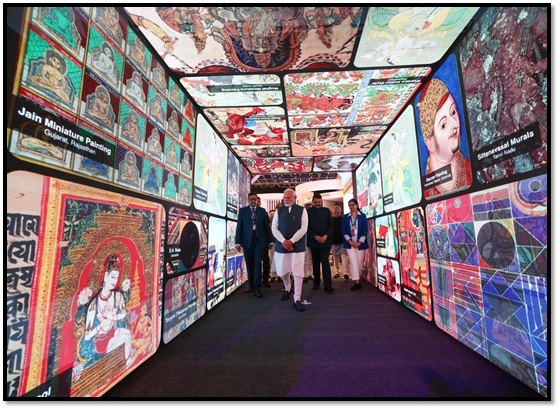
• MoUs signed with industry leaders like Adobe, Google, and NVIDIA to transform IICT into a world-class institution.
Yoga: Uniting Nations Through Wellness
Yoga, an ancient Indian practice has grown into a global movement, promoting harmony of body, mind and spirit. On September 27, 2014, Prime Minister Shri Narendra Modi proposed at the United Nations General Assembly to dedicate June 21st as the International Day of Yoga (IDY).
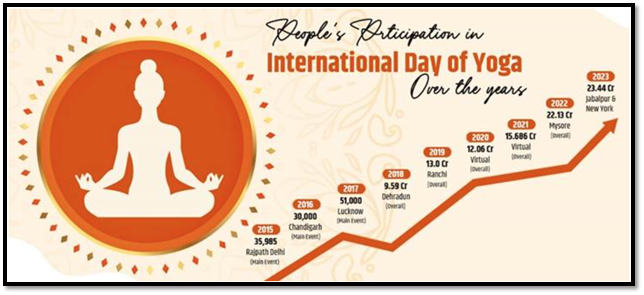
Milestones & Global Achievements of IDY
- The first International Day of Yoga was observed on June 21, 2015 in New Delhi at Rajpath, led by PM Modi.
- 35,985 participants performed 21 yoga asanas with representatives from 84 countries, setting two Guinness World Records.
- In 2022, Yoga was practiced at 75 heritage and iconic sites across India, promoting the fusion of wellness and cultural pride.
- By 2023, participation reached a record high with around 23.4 crore people worldwide joining in the IDY celebrations.
- In 2024 25.93 lakh people in Uttar Pradesh took an online yoga pledge, setting a new Guinness World Record. Akshar Yoga Kendra achieved five Guinness World Records during the celebrations.
- The theme for International Day of Yoga 2025 is "Yoga for One Earth, One Health.”
Global Influence of Ayurveda
Ayurveda is helping position India as a global hub for holistic healthcare. Through the Ministry of AYUSH's Champion Service Sector Scheme, financial support is given to set up super specialty hospitals using traditional systems. These efforts are expanding Ayurveda’s global reach and promoting it as a trusted, ancient healing science for modern health needs. Ministry has been spearheading initiatives that have significantly expanded Ayurveda’s footprint worldwide:
- Global Outreach and Collaborations: The Ministry has signed 24 country-level and 48 institute-level Memorandums of Understanding (MoUs), fostering collaborative research and education. Additionally, 15 academic chairs have been established globally to promote Ayurveda education and research. Ayush Information Cells operate in 39 locations across 35 countries serving as knowledge hubs.
- Strategic Agreements: Milestones include the Donor Agreement with WHO, the MoU on Medicinal Plants Cooperation with Vietnam and the landmark Agreement on Ayurveda with Malaysia and Mauritius. These partnerships advance India’s vision of holistic health for all.
- Recognition and Institutional Support: The establishment of the WHO Global Traditional Medicine Centre in Jamnagar and the inclusion of traditional medicine in ICD-11 by WHO this year mark a significant stride in global recognition of Ayurveda.
- Ayush Visa and Heal in India: Initiatives like the Ayush Visa are facilitating medical tourism, making India a preferred destination for holistic healing.
The success of the 9th Ayurveda Day, celebrated on October 29, 2024, across 150 countries, further demonstrates Ayurveda’s growing global acceptance.
UNESCO: Heritage Milestones
Over the years, India has also expanded its presence on the World Heritage List. In July 2024, a proud addition was made with the inscription of “Moidams: The Mound-Burial System of the Ahom Dynasty” from Assam as a cultural property. With this, India now has 43 sites on the World Heritage List and 62 more on UNESCO’s Tentative List. The country’s journey began in 1983 with the listing of Agra Fort, followed by the Taj Mahal, Ajanta Caves and Ellora Caves. These sites are preserved not only as symbols of history but also as learning spaces for generations to come.Conclusion
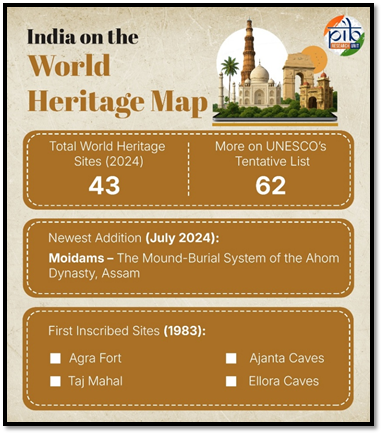
In the last 11 years, India has taken big steps to protect its culture and share it with the world. Ancient temples have been restored, holy places improved and old traditions brought back to life. At the same time, new roads, clean facilities and better services have made it easier for people to visit these places. India is also celebrating its heroes from every region and background. From festivals and yoga to music and art, our culture is now being seen and respected in many countries. People around the world are showing interest in India’s way of life. Today, India’s rich culture is not only shining at home, but also spreading light across the world.
References
Click here to see in PDF
****
Explainer 01/ Series on 11 Years of Government
Santosh Kumar/ Sarla Meena/ Kamna Lakaria
(Backgrounder ID: 154536)
Visitor Counter : 81